
Brown Snake
Latin name: Storeria dekayi
Size: 5 to 15 inches
Venomous: No
ath America, with different species evolving within different habitat types. You may find it underneath rocks or boulders in your back garden, or burrowing around flower beds in residential parks; in the wild, it can be found in marshes, swamps, bogs, grasslands, old fields, and wooded or forested patches.
A secretive snake, the brown snake spends most of its life underground, or burrowing beneath leaf litter or similar floor coverings. Here it can find its primary food sources: slugs, snails, and earthworms.
Eastern Coachwhip
Latin name: Coluber flagellum flagellum
Size: 42 to 60 inches
Venomous: No
The eastern coachwhip is a pretty scary looking snake, but it looks more scary than it actually is. It isn’t venomous, but it does move fast; and it also grows to quite some length. The average falls between 42 to 60 inches, but specimens have been captured and measured at almost double that.
The scales of this snake look like a braided-style whip, giving the species its name, and it is usually black or dark brown in colour, with a much darker head fading into a lighter-coloured body. It is sometimes confused with the indigo snake, because of its colouration; and also the rattlesnake, because of the defensive way it uses its tail when cornered.
 Copperhead
Copperhead
Latin name: Agkistrodon contortrix
Size: 20 to 40 inches
Venomous: Yes
This snake is known to be aggressive when faced with domestic pets and other animals, which can often lead to conflicts between dog walkers (for example) and the copperhead. Hiding away in long grasses and other forms of vegetation, it would be an easy mistake to make to step on one and get bitten by accident, and it must be remembered that the copperhead - usually as copper in colour as the name would suggest - is a venomous snake found in North Carolina.
Red Corn Snake
Latin name: Pantherophis guttatus
Size: Up to 70 inches
Venomous: No
This snake is a non-aggressive and non-venomous snake, quite common across North America. Despite being harmless, it often falls prey to human attack, confusing the species with one of the venomous ones, usually the copperhead. The corn snake does try its hardest to stay hidden, however, burrowing beneath loose leaf litter and hiding beneath boulders, fallen logs, and tree or rock piles. In residential areas, these wild safety coverings are replaced by things such as patios, decking, garden ornaments, and garden furniture.
Mostly active towards the end of the day and into the early part of the evening, they hunt for small rodents, frogs, bats and birds eggs.
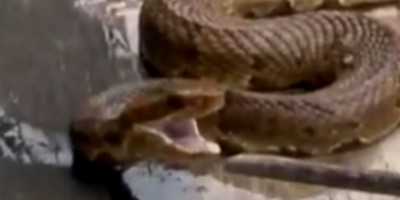 Eastern Cottonmouth
Eastern Cottonmouth
Latin name: Agkistrodon piscivorus
Size: 26 to 70+ inches
Venomous: Yes
The eastern cottonmouth is also just known simply as cottonmouth in North Carolina, as well as the nickname "water moccasin". This is a venomous species, and although fleeing will likely always be the first defense against humans, it won't hesitate to snap and bite, delivering a dose of venom, if continually provoked. We do not recommend touching a snake at all, but especially if you believe it could be a cottonmouth.
Younger cottonmouths tend to have brighter, bolder and lighter colourations and patterns than adults do, which can look almost entirely black, or dark green. The coloring is suited to a life in the water; it can swim very fast and very well, and it finds a lot of its prey in murky waters.
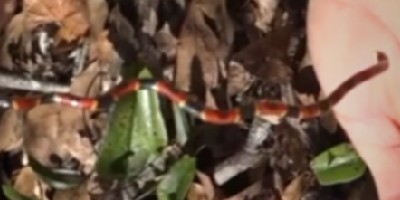 Eastern Coral Snake
Eastern Coral Snake
Latin name: Micrurus fulvius
Size: 18 to 30 inches
Venomous: Yes
It is in the southeastern regions of North Carolina that you may encounter the venomous eastern coral snake — and you can tell that the snake is venomous by looking at the stripes or bands of color. If the yellow and red bands are touching each other, the snake is a venomous one. Many non-venomous snake species mimic the bright markings of the coral snake, but the venomous species have bands of yellow and red that are separated by a black band; they do not touch.
The eastern coral snake enjoys habitats that are brushy, open and dry, such as pine forests and scrub oak forests. Although it is reported to be quite rare for eastern coral snakes to be seen in North Carolina, sightings tend to be all along the coastal plain.
Glossy Crayfish Snake
Latin name: Regina rigida
Size: 13 to 20 inches
Venomous: No
The glossy crayfish snake is quite an elusive one, thought to be quite common across its ranges, but so shy that you probably wouldn’t even be aware if you were close to one. Also known as the glossy swamp snake, striped water snake, glossy water snake, and just simply crayfish snake, the main food is its namesake: the crayfish.
With large eyes, a heavy body, and rather short heads in comparison, they aren't often confused with other snakes, but can easily be missed in the wild, with brown-olive colourations. The underbelly often has a checkerboard-like decoration, setting it aside from other local snakes.
Southeastern Crowned Snake
Latin name: Tantilla coronata
Size: 5 to 10 inches
Venomous: No
This snake can be found in many places, in many habitats, both wet and dry, often beneath piles of rocks, or decaying wood. Forested and woodland habitats tend to be a favorite for the southeastern crowned snake, especially in regions where the substrate is soft, sandy and loose, where they will find termites, centipedes, the larvae of beetles, earthworms, termites, and other insects, all of which make up this snake’s diet. With rear-facing fangs, it is believed that the harmless-to-human venom that this snake injects is designed for invertebrate prey, but the snake is very elusive and experts are still piecing together the facts of this species.
Rough Earth Snake
Latin name: Haldea striatula (Formerly known as Virginia striatula)
Size: 7 to 10 inches
Venomous: No
The earth snake, also known as the striated viper, little striped snake, and various other names, mostly preys on earthworms, although other insects and larvae are sometimes eaten; and it eats prey whole — without constriction or venom. It is a non-aggressive snake, unlikely to attack unless severely provoked or threatened, and being quite small, it can easily slither away into the undergrowth to remain hidden. It is a fossorial species, living and hiding beneath rock piles, fallen trees, logs, in compost heaps, leaf heaps, loose ground vegetation, and other structures in highly vegetated areas.
Smooth Earth Snake
Latin name: Virginia valeriae
Size: 7 to 10 inches
Venomous: No
Both the rough and smooth earth snakes are found in North Carolina — and the smooth earth snake has smooth, glossy scales, just as the name would imply. Often a brown or olive-green colour, occasionally with scattered darker scales that look a lot like random dots, it spends most of its life burrowing in the earth or rustling in the leaves that sit on top of it. This is where it finds prey - the earthworm.
Of all the snakes you might find in North Carolina this is one of the smallest.
Rough Earth Snake
Latin name: Haldea striatula
Size: 7 to 10 inches
Venomous: No
This snake is a non-aggressive one, and one that eats spiders and other insects, rather than small rodents and mammals, which actually provides great benefits for farmers and gardeners alike. As well as worms, slugs, snails, caterpillars, ants, and moths, the rough earth snake also eats spiders, larvae, and others.
With the exception of having keeled scales (rough to touch), the rough earth snake is almost identical to the smooth earth snake in color, pattern, and size.
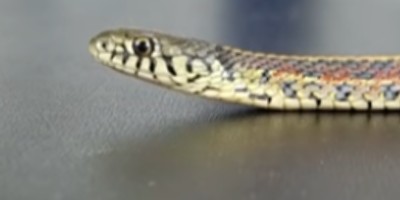 Eastern Garter Snake
Eastern Garter Snake
Latin name: Thamnophis sirtalis
Size: 18 to 54 inches
Venomous: No
The garter snake is one of the most adaptable and widespread snake species found across North America, and North Carolina is home to the eastern garter snake — a snake that prefers to live in grasslands, savannas, and forests, but will usually inhabit any spot that is close to moist grasses or streams.
Often with three stripes running down the body, this species can come in a wide variety of colors, but is usually suited to the watery, highly-vegetated surroundings: brown, olive green, and gray or black.
Rough Green Snake
Latin name: Opheodrys aestivus
Size: Up to 46 inches
Venomous: No
This snake is very slender, very long, and very green — and it likes to spend its time up in the trees, as well as hidden in green vegetation. It is uncommon to find the rough green snake far from a source of water, but they usually inhabit meadows and fields around them, and the species is active during the day.
Because of this snake's small size, its main prey is small insects, but it will also eat other things, such as frogs and snails, providing they are small enough for the snake to devour whole. This snake won’t suffocate prey like a constrictor, but will instead simply swallow it in one go.
Smooth Green Snake
Latin name: Opheodrys vernalis
Size: 14 to 20 inches
Venomous: No
A small and slender snake that has smooth scales and bright green colouration at adulthood, the smooth green snake is one that spends little time in trees and more of its time down on the ground, where it can blend in with the grasslands it chooses to live in, and eat the insects it comes across as it goes about its day.
This snake is active both during the day and night, and cold weather brings the normally solitary snake together in groups for hibernation, which are often the burrows of small mammals and burrows as well as ant hills.
Eastern Hog-Nosed Snake
Latin name: Heterodon platirhinos
Size: 15 to 42 inches
Venomous: No (Yes, but it doesn't affect humans)
Although this snake looks pretty intimidating, its bark is most definitely worse than its bite. The eastern hog-nosed snake, also known as the deaf adder, will puff itself up when faced with conflict, lashing its head and neck back and forth to make it look like it’s ready to strike. In reality, the snake probably won't bite (although this shouldn't be taken for granted), and won't appear to attack humans provided it is left alone.
This snake is designed to eat toxic toads, with a digestive system adapted to counteract the poisonous toxins that toads release as a defense mechanism.
Southern Hog-Nosed Snake
Latin name: Heterodon simus
Size: 14 to 25 inches
Venomous: No (Yes, but it doesn't affect humans)
You will find both the eastern and southern hog-nosed snake in the state of North Carolina. Although the eastern subspecies can be a wide array of colors and patterns, the southern hog-nosed snake is pretty uniform: a light tan or caramel-brown color with much darker brown/black spots that run along the back. Usually, there is a stripe of larger spots along the middle and two stripes of smaller spots running down the sides.
This snake is the very definition of all bark and no bite. They put on quite an impressive display of threatening behavior for humans and other predators, including puffing themselves up, shaking the tale like a rattlesnake does, and even making snapping motions; but rarely does this snake bite.
Eastern King SnakeEastern King Snake
Latin name: Lampropeltis getula getula
Size: 20 to 60 inches
Venomous: No
All king snakes start off around the same time when they are born: up to 11 inches in length. It doesn't take them too long to reach adulthood though, where they can get up to 60 inches. The eastern king subspecies of this snake is just one found in North Carolina, and it is usually black in color, with yellow patterns across the top. The head is normally darker in color, still black, but with either yellow or white-colored spots.
Outer Banks King Snake
Latin name: Lampropeltis getula stricticeps
Size: 20 to 60 inches
Venomous: No
The only place you can find the outer banks king snake is in North Carolina, but that's not the only subspecies of eastern king snake you will find in the state. The nominate species, commonly referred to as just the eastern king snake, is also found here.
You might find it difficult to tell the specific outer banks subspecies apart from other king snakes as it looks very similar: creamy-yellow underbellies with black edges, as well as yellow patterns on top of a lighter yellow backdrop. Some Florida, speckled, and eastern king snakes can also display these colors and markings.
Scarlet King Snake
Latin name: Lampropeltis elapsoides
Size: 14 to 20 inches
Venomous: No
The scarlet king snake is probably one of the most colorful snakes you'll ever see in the state of North Carolina, and you almost wouldn't believe that this snake belongs to the same species (or race) or snake as the milk snake — one that isn't so brightly colored at all.
This snake closely mimics the coloring and markings of a venomous snake: the coral snake. The scarlet snake is non-venomous, however. You can tell this by looking at the bands of color — if black separates the yellow and red, the snake is a non-venomous one.
Northern Pine Snake
Latin name: Pituophis melanoleucus melanoleucus
Size: 45 - 70 inches
Venomous: No
The northern pine snake is an inhabitant of the coastal plains of North Carolina, but numbers have been massively reduced over recent years, so the species has been placed on the list of species of special concern for the state.
This is a large snake, and one that will defend itself when it feels attacked, often with a bite. Before that, there will be warning signs: hissing, a rattling sound, a coiling of the body, and eventually, biting. Although non-venomous, bites from this species have been reported to be quite painful.
This snake spends a great deal of its time living underground, where it rummages through rodent and mammal burrows and feasts on whatever is inside, before then taking up the burrow space itself for a period of time. A great multitasker, the northern pine snake has learned to grab, constrict, and suffocate more than one animal at a time, especially inside the burrow.
Pine Woods Snake
Latin name: Rhadinaea flavilata
Size: 10 to 12 inches
Venomous: No (Yes, but it doesn’t affect humans)
It is thought that there are small and isolated populations of the pine woods along the coastal plains of North Carolina, where they are usually found in low flat-woods of pine (hence the pine woods name). Occasionally, although not frequently, forests and other woodlands can provide a home for this species, as well as tidal marshlands, and the occasional rivers and swamp strands.
This snake can be a range of colors, from an almost gold-yellow shade to red-brown, and even darker brown in some cases. The underside is a much paler color, with an even paler color still under the chin.
Eastern Milk Snake
Latin name: Lampropeltis triangulum
Size: 24 to 36 inches
Venomous: No
The eastern milk snake can come in a wide variety of colors and markings, but usually has brown or gray scales, decorated with large, uneven patches of darker brown, or red-brown. It's generally known to be a non-aggressive species, commonly found within the pet industry, although it's not unusual for the snake to snap when it is being threatened, or feels attacked.
Often a gray or tan color, black-edged, rust-red or brown, uneven patches cover the body, with a white, but dark-blotched, underbelly. It is sometimes mixed up with the corn snake and scarlet snake.
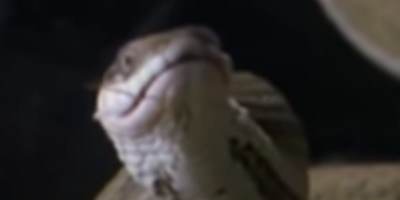 Queen Snake
Queen Snake
Latin name: Regina septemvittata
Size: 13 to 30 inches
Venomous: No
The queen snake is a semi-aquatic snake, so it can commonly be found in or around bodies of water in which crayfish live — clean, rocky-bottomed streams or rivers. Young crayfish with still-soft bodies is the main source of food for the reptile, although it does also feast on tadpoles and smaller fish.
Most water snakes are secretive and shy in nature, but this one appears less so than the others, and it is not uncommon to see the snake basking in the sun on the edges of the water body, or even venturing further away, crossing roads into more human-inhabited areas once the sun goes down.
Southern Black Racer
Latin name: Coluber constrictor priapus
Size: 20 to 56 inches
Venomous: No
Racer by name, racer by nature — this snake will zip away quickly from potential human interruption, but although fast for a snake, it’s still only about 4mph … so not that fast at all. This snake is commonly referred to as just racer, or black racer, and - as the name might imply - the snake is almost entirely black in color. The chin is usually gray or white, and the underside is also gray.
Despite having constrictor in the latin name, the southern black racer doesn't actually suffocate its prey to death. Instead, it coils around the prey items and smashes it to the ground, or crushes prey under its weight. It will then swallow the item whole.
Rainbow Snake
Latin name: Farancia erytrogramma
Size: 36 to 48 inches
Venomous: No
The rainbow snake is stunning to look at, highly-aquatic, very elusive, and is also known by a bunch of other names. This includes eel moccasin (because it primarily feeds on eels in brackish, highly-vegetated water), red-sided snake, striped wampum, and sand snake – among many others.
This snake is mostly black in color, with horizontal bands of red and yellow-orange. The yellow-orange colors tend to come as the snake ages, with the juveniles looking much darker. The tail of this snake is also quite short and pointed, occasionally used as a probe and to hold prey in place (it is believed by experts).
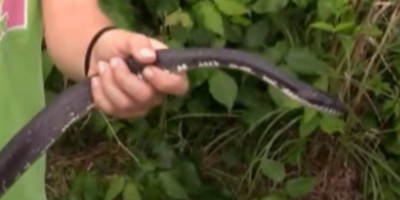 Eastern Rat Snake
Eastern Rat Snake
Latin name: Pantherophis alleghaniensis
Size: 36 to 72 inches
Venomous: No
During the spring and fall months, this snake is active both during the day and night. In the heat of the summer, the eastern rat snake is more active at night, when it is cooler. As well as being a great swimmer, it can chew very well, is a terrestrial burrower, and feeds almost entirely on rats and mice, although is regularly known to branch out into small birds, chickens, frogs, and others.
You are unlikely to see this snake species during the winter; it heads underground or into rock crevices to hibernate. It is common to find the eastern rat snake along with other species of snake, including the copperhead, hibernating together.
Northern Red-Bellied Snake
Latin name: Storeria occipitomaculata occipitomaculata
Size: 8 to 12 inches
Venomous: No
If you were to overturn a few fallen branches or rotting logs in woodlands of North Carolina, you might spot the northern red-bellied snake — a small, slender, often brown snake that feeds on mostly earthworms, slugs, and snails. The body can sometimes be more red in color, and stripes are also occasionally present along the back, but the underside is almost always a red-orange or red-pink shade. The name “occipitomaculata” means to have spots on the back of the head, and that's just what this species has — usually yellow, but the spots can also be black.
Eastern Diamondback Rattlesnake
Latin name: Crotalus adamanteus
Size: 40 to 60 inches
Venomous: Yes
This eastern diamondback rattlesnake usually reaches a maximum length of 60 inches, but specimens are being recorded at longer than that — almost double, in some cases. This particular species of rattlesnake is known for being heavier and larger than most others, and females are smaller than their male counterparts.
This snake has kitted and keeled scales, which means they definitely aren't smooth, and it can come in a range of colors — but always with that infamous diamond-like pattern across the back. Although groups of females can come together for birthing, this is a very solitary snake that can get quite snappy when disturbed.
Carolina Pygmy Rattlesnake
Latin name: Sistrurus miliarius miliarius
Size: 16 to 24 inches
Venomous: Yes
As the name might suggest, the pygmy rattlesnake is a small rattlesnake — the smallest species in North America, actually. It's usually a pale color, often beige or gray, and has darker brown, black or gray uneven dots that cover the body, along both the back and the sides.
Head to the eastern/southeastern regions of North Carolina to spot this tail-shaking species, particularly the sand hills and coastal plains. They can be found there, feeding on frogs, lizards, rodents, and occasionally other snakes. Being small and well-camouflaged means that this species is equally as comfortable being active during the day and the night.
Timber Rattlesnake
Latin name: Crotalus horridus
Size: 36 to 60 inches
Venomous: Yes
The timber rattlesnake is a venomous but quite shy snake inhabiting rocky ridges, uplands woods, and occasionally, swamps and similar bodies of water in which frogs and lizards are in abundance. With populations on the decline, this species is protected in pretty much every state that it is found in, which means that strict restrictions are in place when it comes to removing them from your property, or transporting them in any way. Thankfully, conflicts are rare, and bites are even rarer than that. The snake would much rather you left it alone, and it will hide, or shake its rattling tail around in a bid to ward off potential threats.
Eastern Ribbon Snake
Latin name: Thamnophis sauritus
Size: 18 to 34 inches
Venomous: No
Eastern ribbon snakes have rather long tails when compared to other snakes, especially similar species, and it is usually a dark brown or black color, patterned with stripes that run along the back of the body. There is sometimes a white patch in front of each eye, which are quite large for the head size.
As well as being slender, this snake is an excellent swimmer and is commonly found near bodies of water — marshes, streams, canals, and similar, and even household ponds.
Northern Scarlet Snake
Latin name: Cemophora coccinea copei
Size: 14 to 20 inches
Venomous: No
This snake species feeds on the eggs of other snakes and reptiles, using oversized teeth to crack open the ones that won’t fit into its mouth. When eggs aren't available, the snake will also feed on small snakes and lizards as well as frogs, toads, and other smaller amphibians.
Terrestrial burrowers by nature, they spend a lot of their time burrowing underground, or under soft ground covering, especially in soft and/or sandy soils. Although a very secretive snake, it is not uncommon to turn over garden furniture, rock/log piles, or trash cans/piles to find one of these curled up underneath.
Carolina Swamp Snake
Latin name: Seminatrix pygaea
Size: 10 to 15 inches
Venomous: No
This snake lives to live in heavily vegetated waters, such as cypress swamps, and it rarely leaves the safety of the water to venture out on to land. The snake even gives birth in the water - live young, up to 13 at a time - usually in much shallower swamp and marsh waters.
This snake is mostly black on top and red underneath, but the belly can be a range of pink, red and orange tones. It’s easily mixed up with other species that also have red bellies. It doesn’t have a discernible neck, and the scales are very smooth and glossy.
Banded Water Snake
Latin name: Nerodia fasciata
Size: 24 to 45 inches
Venomous: No
Also known as the southern water snake, the banded water snake is just one of many aquatic or semi-aquatic snakes found across the state of North Carolina. As with other water snakes, the colourings and markings of this one can lead people to believe it is a cottonmouth snake, which is venomous. The banded water snake is not venomous, however, and has a flatter head. It is also more likely to act defensively than to attack when humans are close, releasing a fluid from their anal glands that smells musky and very unpleasant.
Brown Water Snake
Latin name: Nerodia taxispilota
Size: 30 to 60 inches
Venomous: No
Some may know North Carolina's brown water snake by one of many other names, such as southern water snake, pied water snake, and water-pilot. It is a thick and heavy snake, with a light-brown colored body, decorated with square-shaped spots of a much darker brown shade. To look at, the pattern that runs down the back and sides of the snake looks very much like a checkerboard pattern.
This snake is commonly seen basking in the sun on branches of trees that lead out across the water, and usually inhabits the areas around the edges of streams, rivers, and lakes.
Northern Water Snake
Latin name: Nerodia sipedon
Size: 20 to 55 inches
Venomous: No
The northern water snake is one of the scavengers of the water snake world, feeding on dead fish, live fish, other snakes, tadpoles, newts, salamanders, frogs, toads, small mammals, and small birds. They are a mostly aquatic snake, inhabiting bodies of water, or close to it. This can include ponds, streams, lakes, slow-moving rivers, swamps, bogs, and marshes.
Although a mostly solitary snake, the northern water snake is seen in groups during the summer, coming together to bask. Breeding season is also in early summer — from April to June.
Plain-Bellied Water Snake
Latin name: Nerodia erythrogaster alta
Size: 24 to 40 inches
Venomous: No
The plain-bellied water snake inhabits eastern regions of North Carolina, close to lakes, ponds, swamps, river sloughs, marshes, bogs, and other temporary or permanent bodies of water. Although capable of spending great lengths of time away from water, their main food source is frogs and toads, also branching out into small fish, crayfish, and salamanders, and tadpoles. They, in turn, are prey to various other snakes, including cottonmouths, as well as larger fish, birds of prey, and mammals.
The copper-bellied subspecies (formerly known) of water snake is listed as threatened by the U.S. Fish and Wildlife Service, and northern populations seem to have suffered the most.
Red-Bellied Water Snake
Latin name: Nerodia erythrogaster erythrogaster
Size: 24 to 60 inches
Venomous: No
You may find the red-bellied water snake in the northern counties of North Carolina, and it is a semi-aquatic species that is known to travel quite far from the body of water it usually inhabits, which is unusual for water snakes. Rivers, swamps, and lakes are preferred habitats, where it feeds on salamanders, frogs, toads, tadpoles, and earthworms, alongside other, soft-bodies bugs.
The belly of this snake is not only red (or orange-red), but also unmarked, and the underside of the head and neck is often a lighter shade than the rest of the belly. Younger snakes have markings along the back but these fade away as the snake gets older.
Worm Snake
Latin name: Carphophis amoenus
Size: 7 to 11 inches
Venomous: No
The humble worm snake - a snake that very much resembles a large worm - can be found almost everywhere across the state of North Carolina, particularly in moist woodlands. Not only does this species of snake look like a worm, but it also eats worms — almost exclusively earthworms.